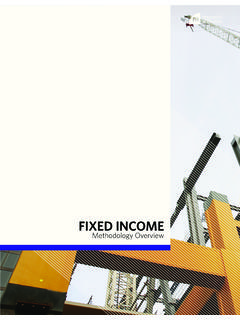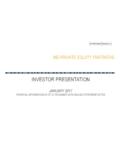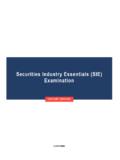Transcription of EQUITY - Research Affiliates
1 EQUITYM ethodology OverviewREVISION DATE: 10/1/2014 OVERVIEW ..1 What is This Document? ..1 Time Horizon ..2 EQUITY ..3 Asset Class Overview ..3 Expected Return Methodology ..5 Yield ..5 Growth ..7 Valuation ..10 Results ..12 REFERENCES ..14 TABLE OF CONTENTSOVERVIEW We understand that some of our insights will never find their way into products, but we provide them in support of investors and the finance community. ROB ARNOTTCHAIRMAN & CEOEQUITY | 1 What is This Document?This is one in a series of plain-language white papers setting forth Research Affiliates building block approach to developing long-term capital market expectations by asset class. (For information about the objectives and guiding principles of our asset allocation initiative, please refer to Capital Market Expectations: Methodology Overview, the first of these white papers.)
2 In working out our risk and return forecasts and making them publicly available, we keep three criteria in mind: transparency, robustness, and timeliness. By describing the conceptual framework and calculations behind the projected asset class risks, returns, and correlations in these papers, we hope to achieve a meaningful level of transparency without excessive details. By constructing simple, economically sound models for major asset classes, we strive to achieve a fitting standard of robustness for forecasting to a 10-year horizon. By initially refreshing our expectations on a quarterly basis, we seek to provide information that is updated with useful frequency. We will continue to refine our methods, extend the scope of our capital market expectations, and improve this documentation over remainder of this document addresses how we think about EQUITY returns from a building block perspective, and provides transparency into the methods employed to develop these return expectations.
3 2 | EQUITYTime HorizonOne of the major considerations when embarking on the journey to generate asset class return expectations is the consideration of time horizon. Because the focus here is on generating capital market expectations for strategic asset allocation, and not tactical overlays, a significantly long time horizon of 10 years was 10-year time horizon is not meant to imply a 10-year buy-and-hold strategy, but instead incorporates a strategy consisting of asset classes each with a constant duration target. Said another way, for asset classes with shorter durations ( , fixed income), these asset classes need to be periodically rebalanced to maintain the constant duration. The rebalance period chosen here is one year which means that a two-year bond, for example, will be held for one year, at which time the bond with one year remaining to maturity would be sold and the proceeds are used to purchase a new two-year bond.
4 Asset classes with significantly long duration ( , equities) can be considered buy-and-hold because the change in duration from the passage of 1, 2, or even 10 years on these types of assets is | 3 EquityAsset Class OverviewEquity securities represent a major asset class, and, like debt instruments, they provide a way for corporations to raise capital. People who own these securities do not enjoy the highest claim on company earnings; their claims are subordinated to creditors claims, and the owners of EQUITY securities enjoy distributions from earnings only after the creditors higher priority claims are satisfied. Today there is a seemingly countless number of EQUITY securities and indices. Research Affiliates currently covers a select set of approximately 30 diversified indices, and the methodology used in the creation of their forecasts can easily be extended to a broader array of EQUITY Large CapS&P Small CapRussell 20003 AustraliaMSCI Australia4 CanadaMSCI Canada5 FranceMSCI France6 GermanyMSCI Germany7 Hong KongMSCI Hong Kong8 ItalyMSCI Italy9 JapanMSCI Japan10 SpainMSCI Spain11 SwedenMSCI Sweden12 SwitzerlandMSCI Switzerland13 United KingdomMSCI UKSource.
5 Research AffiliatesTABLE 1 Developed Market Representative Indices4 | EQUITY1 BrazilMSCI Brazil2 ChinaMSCI China3 IndiaMSCI India4 IndonesiaMSCI Indonesia5 MalaysiaMSCI Malaysia6 MexicoMSCI Mexico7 PolandMSCI Poland8 RussiaMSCI Russia9 South AfricaMSCI South Africa10 South KoreaMSCI South Korea11 TaiwanMSCI Taiwan12 ThailandMSCI Thailand13 TurkeyMSCI TurkeySource: Research Affiliates1 All MarketsMSCI ACWI2 Developed MarketsMSCI World3 EuropeMSCI Europe4 Dev ex-NA EquityMSCI EAFE5EM EquityMSCI Emerging MarketsSource: Research AffiliatesTABLE 2 Emerging Market Representative IndicesTABLE 3 Composite Representative IndicesEQUITY | 5 Tables 1-3 represent only a small portion of the entire universe of EQUITY indices, and the indices identified aren t the only indices available to represent these countries or regions.
6 For regional and global composites, indices are first modeled country by country, and then combined with each country s current weight in the composite to derive the aggregate return Return MethodologyThe goal of this modeling framework is to provide a set of mutually exclusive and cumulatively exhaustive components with which to collectively capture drivers of return. As discussed in the corollary methodology overview document, EQUITY returns can be decomposed into a set of building blocks:1. Income Return 2. Earnings Growth3. Multiple Expansion1 Accordingly, it should come as no surprise that the components used in forecasting EQUITY returns, although named differently, are nearly identical to the decomposition components as described in Grinold and Kroner (2004).
7 The first component, current dividend yield, has proven to be the one reliable component of stock ownership over the last two centuries. It represents the means by which long-term investors earn much of their internal rate of return (Arnott and Bernstein, 2002). The second component is real earnings growth or, conceptually, the portion of a country or region s economic growth in which index constituents participate. In the absence of changes in EQUITY multiples, using the current dividend yield plus a small premium for real earnings growth creates a reasonably accurate measure of future stock index returns. The third component is change in valuation. Value-oriented investors have always asserted that valuation multiples indicate whether a stock market is over- or undervalued (Campbell and Thompson, 2008).
8 Under the commonly held assumption that valuation multiples are mean-reverting, high multiples (and correspondingly low dividend yields) should lead to lower future returns and vice versa. The final component represents currency returns available through unhedged foreign this model, the easiest part of forecasting real stock returns is the dividend yield: It s a known fact. The assumption is that current dividend yield is fair and is an unbiased estimator of future yields. 1 This component includes expansion/contraction of valuation multiples as well as the second-order interaction of growth and multiple See the Domestic and Foreign Cash Methodology document for details on currency return modeling and ReturnCurrent Dividend Yield Real Earnings GrowthValuation Currency Adjustment =++ +Dividend Per ShareDividend YieldPrice=6 | EQUITYW hile simple to forecast because it is readily observable, the current dividend yield is no less important than the other components of EQUITY return expectations.
9 Moreover, the conventional view is unfounded: It is not the case that equities derive most of their returns from capital appreciation and that income is far less important, if not irrelevant. (Arnott and Bernstein, 2002) In fact, from 1802 2010, 75% of the real return on equities came from the dividend yield, clearly making this component a significant contributor to overall return. Over the last 140 years, the average annual dividend yield in the United States has been (see Table 4). Over the last 30 years, however, the dividend yield has fallen to less than half that value. Time PeriodAverage Dividend Yield1871 : Research Affiliates , based on data from the Robert Shiller DatabaseSince 1990, both real prices and real dividends per share have increased, but prices have grown at a faster rate.
10 This has lead to multiple expansion, a topic which is covered later in this document. For now it s important to realize that, although dividends per share have risen, they are growing at a slower rate than earnings per share, due to a consistently shrinking payout ratio (see Figure 1).TABLE 4S&P 500 Real Dividend Yield Over TimeEQUITY | 70%20%40%60%80%100%120%140%160%Source: Research Affiliates , based on data from the Robert Shiller DatabaseA natural assumption is that the reduced payout ratio, and correspondingly increased retained earnings, lead to higher and higher future growth rates; however, it has been shown that, in fact, the opposite is true. Lower payout ratios do not lead to higher future growth (Arnott and Asness, 2003).







![final reg 28 public forums rev 2.ppt [Read-Only]](/cache/preview/8/9/c/5/5/c/f/f/thumb-89c55cff371e875fb5aee0978f80d3fd.jpg)
